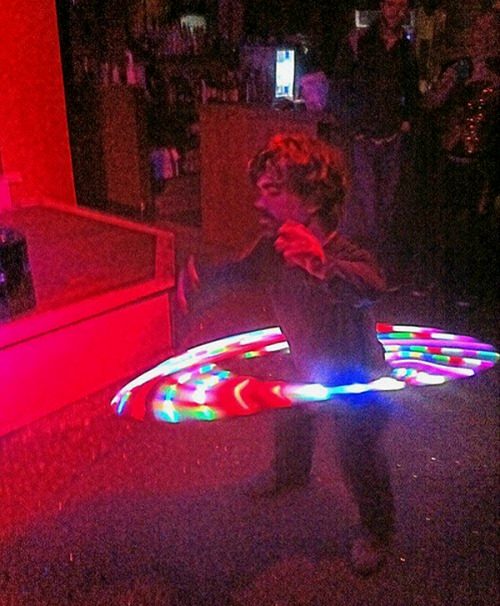Noisli is a background noise generator ideal for working and relaxing. (Plus Text Editor for distraction-free writing with plain text and Markdown support.)
So simple. So neat.
Noisli is a background noise generator ideal for working and relaxing. (Plus Text Editor for distraction-free writing with plain text and Markdown support.)
So simple. So neat.


The slow death of the death penalty in America

Russian Sledgesvia willowbl00

In ordinary circumstances, it would be fair to say that your paranoia levels are off the charts if you really think a nearby lamp is spying on you. But that might not be an accurate assessment anymore now that surveillance devices can be placed virtually anywhere – especially with the arrival of the Conversnitch. This cheap device looks like an ordinary light bulb, but it records the conversations of oblivious strangers and posts them on Twitter.

Artists Kyle McDonald and Brian House built the device for a mere $100 using Raspberry Pi and a microphone to record audio. It works anywhere with access to wifi. The text translation isn’t instantaneous, however; rather than using a talk-to-text translator, the artists pay to have the audio transcribed through Amazon’s Mechanical Turk crowdsourcing platform. McDonalds, libraries, public parks, cafes – no place is safe.

Most of the overheard conversations are predictably banal. Snippets from the Conversnitch Twitter account include things like “I had the best dream this morning! It was about Eddie Vedder and we were swimming in a pool and in love.” “Did you eat any of my tater tots while I was gone? It sure looks like you did ’cause I couldn’t have eaten that many.”

The creators acknowledge that a device like this could be used for illegal purposes, and infringe upon privacy rights and expectations. They aim to stimulate conversation about how surveillance devices can disrupt what we believe should be private moments. But given that they provide full instructions to build your own cheap surveillance lamp, they’re making it disturbingly easy to disseminate devices that do just that.







Russian Sledges"Asking students to evaluate their professors anonymously is like Trader Joe’s soliciting Yelp reviews from a shoplifter."
via firehose
Under the Skin, starring Scarlet Johansson as an alien come to Earth in human form, is being billed as a science-fiction film, and it is, on some level. But with early scenes structured around Johansson’s “stalking” of various humans and a finale that echoes back to Frankenstein, director Jonathan Glazer’s film hews closer to horror. Even as that, however, it’s clearly something different, with a narrative and a visual and aural strategy that belong more to the realm of the experimental. In his review of the film, our own David Edelstein said it “takes the horror genre in infectiously strange new directions.” And he’s right. Glazer clearly has more on his mind than telling a tale about something that comes to Earth and harvests men. His film could be interpreted as a meditation on human sexuality, on modern alienation, on the existential chasm between flesh and being — all conveyed through a filmic style that privileges the physical, even as it (mostly) keeps the viewer at an emotional distance.
Similarly, Jim Jarmusch’s Only Lovers Left Alive, about two centuries-old vampires whose love persists even though they’ve largely absented themselves from the world of humans, is a genre movie in name only. Yes, there are vampires in the film, and yes, they drink blood, but Jarmusch is more interested in using the idea of vampirism to explore the idea of outsiderism. His film is as much about the murmur of half-abandoned cities beyond the characters’ car windows as it is about fangs and blood.
These two films are very different from one another, but both are somber, symbolic, even trancelike. As such, they’re perfect examples of “art-horror” (or “arthouse horror”) — a type of film that represents a fascinating byproduct of the collision of art and commerce, of genre convention and personal vision. In the past, you could market a movie as a horror flick and get some unwitting viewers into the theater before they realized the film was something entirely different. That’s not quite possible nowadays, but art-horror does provide one way of giving audiences something new, in the guise of the familiar.
Art-horror films tend to rely more on atmosphere and style to create an unnerving experience than on actual “scares.” They may have characters or situations that lend themselves to typical horror narratives, but very often they work against viewer expectations by unfolding in elliptical ways, or keeping the actual horrors offscreen, or sending their stories in new, surreal directions. But art-horror is also hard to define, since as a sub-genre it is by necessity inexact and fluid. Many horror films can be works of art without being “art-horror.” John Carpenter’s The Thing or George Romero’s Night of the Living Dead or Ridley Scott’s Alien are masterpieces of horror, but they’re not necessarily art films. But what about Stanley Kubrick’s The Shining, which spends so much of its running time just building and building, and presents its one actual “kill” as almost a sacrifice to the genre gods? Or David Cronenberg’s The Brood, which is as much a domestic nightmare as it is a F/X-laden gore-fest? Or David Lynch’s Blue Velvet, which draws so much of its power from its unsettling vision of suburbia than from anything that could be considered thrilling? The fact is that everyone will define “art-horror” in their own way — the same way they define “art film” in different ways.
A good litmus test for what one considers art-horror is F.W. Murnau’s 1922 vampire classic Nosferatu. Yes, it’s one of the most influential horror films of all time, and yes, it’s still terrifying, full of images that have since become part of the horror genre’s collective unconscious. But it’s also a rather odd beast: moody, elusive, aestheticized. In many ways, it’s an ancestor to both the traditional horror film and the art-horror film. Murnau had set out to make a genuinely frightening movie — and he did, but the result was less a piece of genre pulp and more a funereal meditation on the uncanny. (When Werner Herzog remade it as Nosferatu the Vampyre in 1979, the result was pure art house, a hypnotic, deliberate film about sexuality, disease, and otherness.)
Nosferatu clearly influenced Carl Theodor Dreyer's bizarre 1932 film Vampyr, which is art-horror par excellence. Hallucinatory and perplexing, it tells the story of a young traveler who, as the opening titles tell us, became so obsessed with the supernatural that “for him the boundary between the real and the unreal became blurred.” That could apply to the film itself, which unfolds as a series of nightmarish images that the protagonist, about whom we know practically nothing, witnesses in and around an old inn. Shadows have minds of their own; men with scythes walk ominously in distant fields; unseen figures seem to hover on the edges of the screen. There’s little rhyme or reason to the plot, and we’re denied any real resolution or explanation. Instead, we’re carried along by the force of the film’s atmosphere and the discomfiting nature of the imagery.
The 1930s was a pivotal decade for horror. The genre became industrialized as Universal Pictures began to churn out now-classic monster movies — Dracula, Frankenstein, and The Mummy. But not long on the heels of this phenomenon came a new wave of art-horror. Consider the cinema of producer Val Lewton, who was enlisted by RKO Pictures to make cheap movies, and turned the studio a nifty profit with films like Cat People (1942), I Walked With a Zombie (1943), and The Leopard Man (1943).
Lewton had very limited means, but he and his directors (particularly Jacques Tourneur, who directed those three films) had a surfeit of artistic ambition. And so, they created elegant, serious works, using psychological unease rather than any obvious special effects; very often, you never saw the monstrosity. (In Cat People, a woman is convinced that she has a curse on her that will turn her into a deadly panther whenever she has any strong emotions; I Walked With a Zombie is as much influenced by Jane Eyre as it is by anything to do with zombies.) These films were more than just artful — the use of implied horror suggests that we are witnessing something inward, something about the character’s own subjectivity rather than any outside terror.
If I’m dwelling a lot on these earlier, historical works, that’s because I think people like Murnau, Dreyer, and Lewton (and to some extent Tod Browning, the visionary director of films like Freaks and The Unknown, as well as Universal’s Dracula) in many ways established the template for modern-day exercises in art-horror. You can see traces of their influence in key art films from the 1960s — works as diverse as Georges Franju’s Eyes Without a Face (1960), Herk Harvey’s Carnival of Souls (1962), Roman Polanski’s Repulsion (1965), Ingmar Bergman’s Hour of the Wolf (1968), or even Masaki Kobayashi’s Kwaidan (1964), one of the earliest “J-horror” films.
The 1970s saw the emerging popularity of big-budget “serious” horror films like The Exorcist (1973) and The Omen (1976), as well as American slasher films like Texas Chainsaw Massacre (1974) and Halloween (1978). There was also the continental popularity of Italian giallo like Twitch of the Death Nerve (1972) and Suspiria (1977). Again, reasonable minds may disagree, but these films all generally belong in the more traditional horror category, even though many of them achieved new levels of artistry and boundary pushing.
But during this period the art-horror film would also enter an important new phase. In 1977, the first feature film from America’s true giant of art-horror, David Lynch’s Eraserhead, would define the sub-genre for decades to come — with its surreal storyline, its procession of unnerving imagery, and its mesmeric, industrial rhythms. (Before he made The Shining, Stanley Kubrick himself would reportedly call Eraserhead the greatest film he’d ever seen and screen it for his cast and crew.) Lynch’s later films fit the art-horror label to varying degrees: Blue Velvet (1986), for all its craziness, is a fairly straightforward movie, while Lost Highway (1997), uh, is not. But almost all of his films seem to absorb the very monstrousness that they’re depicting. When Lynch portrays fragmented identities and environments, as he does in Inland Empire (2006) and Lost Highway, he fragments the films themselves, and by extension our experience as viewers.
Lynch’s career testifies to the fact that the broad strokes of horror lend themselves well to works of personal expression — the supernatural and uncanny are a perfect excuse to explore the dreamlike and the symbolic. Robert Altman was never more “art house” than he was with his 1972 film Images, a dreamlike thriller about a young wife slowly going mad. The same could be said for Claire Denis, whose demented 2002 erotic cannibal movie Trouble Every Day, starring Vincent Gallo and Béatrice Dalle, might be her most confounding film (it’s also one of her most beautiful).
Ditto for Polish director Jerzy Skolimowski’s 1978 cause célèbre The Shout, one of the strangest films I’ve ever seen, which features Alan Bates as a stranger who upends the life of a married couple with his ability to kill with a so-called Aboriginal shout. Or Andrzej Zulawski’s twisted domestic thriller Possession (1981), in which Sam Neill has to watch his wife, Isabelle Adjani, make love to a gruesome tentacle creature. I mentioned J-horror briefly earlier. Many of the genre films coming out of Asia in recent decades appear to have taken the lessons of art-horror to heart — particularly in works like Kiyoshi Kurosawa’s incantatory serial killer drama-cum-domestic nightmare Cure (1997) and Takashi Miike’s rape-revenge mindfuck Audition (1999). These are films that look pulpy and sensationalistic on paper, but cinematically, they’re highly stylized, experimental, constantly challenging the viewer and seeking to put us in a troubled state of mind.
If these last few films all seem to be about fears of sex and domesticity to some degree, you’re right. In all of these films, you have directors tackling very personal stories about deep, unsettling urges, and about human relationships. If horror’s great theme is the unnatural and uncanny — the idea of revulsion, not just in terms of gore but also in terms of emotion and state of mind, lies at the heart of the genre — then art-horror’s twist is to turn the camera inward. In other words, the films themselves are often unnatural and uncanny. Under the Skin places us in the world of the alien; even though we can’t relate to her, the film is essentially shot from her perspective. As Glazer himself has said, “[The film] had to be told from her viewpoint. Or its viewpoint. So the film had to be her experience.” And one of the things that make the film so terrifying is that the alien’s victims so rarely seem to experience any fear. Are they under a spell? Maybe. Or maybe the alien has no conception of fear yet — and, because we’re essentially watching through her eyes, neither do we.
Meanwhile, in Only Lovers Left Alive, we not only see things through the eyes of the vampires, we inhabit a world where they often seem to be the only presences around. The film adopts their desolate, apocalyptic spirit. Jarmusch’s direction doesn’t feel experimental the way Glazer’s does, but while watching it, you sense that you have a direct feed into the director’s brain. He has never been one to make an anonymous film, but this feels like his most personal work in years – he confirmed as much during my recent interview with him.
In both these films — and other recent examples of art-horror, like the grim Jake Gyllenhaal doppelganger thriller Enemy, or last year’s surreal, gothic family drama Stoker — you can sense an increasing unease about the individual's place in the world. Their characters are at first secure in their isolation, but gradually, their boundaries break down, and they begin to feel lost, adrift. It could be said that their journeys mirror our own. Art-horror alienates the viewer and in so doing forces us to question our relation to the world around us. Remember that haunting, deeply troubling line from Blue Velvet: “He put his disease into me.” You could say that art-horror films try to put their disease into us.
Read more posts by Bilge Ebiri
Filed Under: movies ,brief histories ,only lovers left alive ,under the skin ,horror ,horror movies ,nosferatu ,vampyr ,jacques tourneur ,jonathan glazer
 Studio Cheha in Tel Aviv, Israel is behind this innovative LED lamp that tricks your mind into thinking it's looking at a 3D object. BULBING is a 2D lamp created using 3D wire-frame images. By transferring those images onto 2D materials, through a laser machining process, your eyes become fooled. The changeable design is made from acrylic glass sheet and the base is made of plywood birch. The light is LED, giving it a lifespan of 50,000 hours.
Studio Cheha in Tel Aviv, Israel is behind this innovative LED lamp that tricks your mind into thinking it's looking at a 3D object. BULBING is a 2D lamp created using 3D wire-frame images. By transferring those images onto 2D materials, through a laser machining process, your eyes become fooled. The changeable design is made from acrylic glass sheet and the base is made of plywood birch. The light is LED, giving it a lifespan of 50,000 hours.








Russian Sledges"that song from 'a field in england'"
warning: this page contains the auto-playing midi file of yesteryear
Russian Sledgesvia jon bernhardt's radio show
Russian Sledgesattn overbey
Russian Sledgesvia willowbl00

From Facebook
After spending years developing a simple machine to make inexpensive sanitary pads, Arunachalam Muruganantham has become the unlikely leader of a menstrual health revolution in rural India. Over sixteen years, Muruganantham’s machine has spread to 1,300 villages in 23 states and since most of his clients are NGOs and women’s self-help groups who produce and sell the pads directly in a “by the women, for the women, and to the women” model, the average machine also provides employment for ten women.
Muruganantham’s interest in menstrual health began in 1998 when, as a young, newly married man, he saw his wife, Shanthi, hiding the rags she used as menstrual cloths. Like most men in his village, he had no idea about the reality of menstruation and was horrified that cloths that “I would not even use… to clean my scooter” were his wife’s solution to menstrual sanitation. When he asked why she didn’t buy sanitary pads, she told him that the expense would prevent her from buying staples like milk for the family.
Muruganantham, who left school at age 14 to start working, decided to try making his own sanitary pads for less but the testing of his first prototype ran into a snag almost immediately: Muruganantham had no idea that periods were monthly. “I can’t wait a month for each feedback, it’ll take two decades!” he said, and sought volunteers among the women in his community. He discovered that less than 10% of the women in his area used sanitary pads, instead using rags, sawdust, leaves, or ash. Even if they did use cloths, they were too embarrassed to dry them in the sun, meaning that they never got disinfected — contributing to the approximately 70% of all reproductive diseases in India that are caused by poor menstrual hygiene.
Finding volunteers was nearly impossible: women were embarrassed, or afraid of myths about sanitary pads that say that women who use them will go blind or never marry. Muruganantham came up with an ingenious solution: “I became the man who wore a sanitary pad,” he says. He made an artificial uterus, filled it with goat’s blood, and wore it throughout the day. But his determination had severe consequences: his village concluded he was a pervert with a sexual disease, his mother left his household in shame and his wife left him. As he remarks in the documentary “Menstrual Man” about his experience, “So you see God’s sense of humour. I’d started the research for my wife and after 18 months she left me!”
After years of research, Muruganantham perfected his machine and now works with NGOs and women’s self-help groups to distribute it. Women can use it to make sanitary napkins for themselves, but he encourages them to make pads to sell as well to provide employment for women in poor communities. And, since 23% of girls drop out of school once they start menstruating, he also works with schools, teaching girls to make their own pads: “Why wait till they are women? Why not empower girls?”
As communities accepted his machine, opinions of his “crazy” behavior changed. Five and a half years after she left, Shanthi contacted him, and they are now living together again. She says it was hard living with the ostracization that came from his project, but now, she helps spread the word about sanitary napkins to other women. “Initially I used to be very shy when talking to people about it, but after all this time, people have started to open up. Now they come and talk to me, they ask questions and they also get sanitary napkins to try them.”
In 2009, Muruganantham was honored with a national Innovation Award in 2009 by then President of India, Pratibha Patil, beating out nearly 1,000 other entries. Now, he’s looking at expanding to other countries and believes that 106 countries could benefit from his invention.
Muruganantham is proud to have made such a difference: “from childhood I know no human being died because of poverty — everything happens because of ignorance… I have accumulated no money but I accumulate a lot of happiness.” His proudest moment? A year after he installed one of the machines in a village so poor that, for generations, no one had earned enough for their children to attend school. Then he received a call from one of the women selling sanitary pads who told him that, thanks to the income, her daughter was now able to go to school.
To read more about Muruganantham’s story, the BBC featured a recent profile on him at http://bbc.in/1i8tebG or watch his TED talk at http://bit.ly/1n594l6. You can also view his company’s website at http://newinventions.in/
To learn more about the 2013 documentary Menstrual Man about Muruganantham, visit http://www.menstrualman.com/
For resources to help girls prepare for and understand their periods - including several first period kits - visit our post on: “That Time of the Month: Teaching Your Mighty Girl about Her Menstrual Cycle” at www.amightygirl.com/blog?p=3281
To help your tween understand the changes she’s experiencing both physically and emotionally during puberty, check out the books recommended in our post on “Talking with Tweens and Teens About Their Bodies” at http://www.amightygirl.com/blog?p=2229
And, if you’re looking for ways to encourage your children to become the next engineering and technology innovators, visit A Mighty Girl’s STEM toy section athttp://www.amightygirl.com/toys/toys-games/science-mathAwesome, dude. Awesome. I mean, AWESOME.
WHAT AN EPIC BADASS!
This man is awesome!
Man. You’re doing it right.

It's not often that weather rolls in carrying a distinct "mouthfeel." Yet that's been the case the last few days in China, where a massive windstorm coated buildings, cars, and tongues with gritty desert dust.
Northern China's not unaccustomed to dust barrages triggered by Siberian weather fronts to the north. This one's a bit different: It moved eastward across the country with incredible speed and power. Look how far the leading dust-wall had surged in these NASA satellite images, taken on Wednesday at 12:35 p.m. local time and then 2:20 p.m.:
And this satellite shot looking down at the Taklamakan Desert shows the storm was still mightily riled up on Thursday:

The Chinese media is calling it the largest sandstorm to hit the region in a decade; NASA has settled for "China’s Great Wall of Dust." Cities and towns engulfed in the particle swell experienced visibility conditions of 60 to 160 feet, and the composition of the dust made the sky glow orangish-yellow, like the inside of a jack-o-lantern. In some places, trains were delayed, roads shut down, and school children kept at home until the cold front carrying the dust dissipated.
What's it like to be in the middle of one of these things? Footage from Wednesday in Gansu Province provides the answer – it's pretty miserable:
(SAN JOSE, Calif.) — A United Nations official says the mother of a California teenager who stowed away on a flight to Hawaii is living in a refugee camp in Ethiopia.
Ubah Mohammed Abdule, 33, is living at the Sheder Refugee Camp in Ethiopia, said the official from the UN High Commissioner for Refugees office on Friday. According to the UN, the camp houses about 10,200 displaced Somalis.
The official was not authorized to speak and asked to remain unnamed.
The boy’s father told Voice of America his son was always talking about going back to Africa.
Somalia has been plagued with internal conflict, drought and violence for decades. Today, more than 1 million Somali refugees are living in neighboring Kenya, Ethiopia and Yemen.
Russian Sledgesactual instructions for this pattern seem to be print-edition-only, but there is a some related tutorial on stitches here: http://www.threadsmagazine.com/item/8893/stitches-for-gorgeous-gloves
and possibly useful images here: http://www.threadsmagazine.com/item/8894/gallery-of-gorgeous-gloves-by-john-koch
and some semi-useful stuff about fitting buried in the comments
Russian Sledgesvia rosalind




Costume designed by Gabriella Pescucci for Michelle Pfeiffer in A Midsummer Night’s Dream (1999)
From Tirelli Costumi
Russian Sledgesvia rosalind



The only thing you need to see.. Peter dinklage and Lena Heady hula hooping at a gay bar.
Russian Sledgesvia firehose
Russian Sledgesvia multitask suicide
If it’s been a while since you dipped your toe into the apocalyptic fringe, why not have a look today? “The Prepper: Part One”, “Oh Sh!t… The Awakening”, “Grid Down: Perceptions of Reality”, “Society’s Collapse: A Long Road Ahead”, and “Equipping Modern Patriots” are some of the best-selling books in the genre of Prepper Fiction, a masturbatory fantasy by and for people who keep food and guns in their basement. The message, of course, is that it’s actually good and smart to hoard bullets and bags of rice, not a delusion or fantasy about using the end of society to acquire the power and resources they lack here in the real world.
In case you’re not tempted yet to hit the “look inside” link to read these (which you can do on the product page) – each and every one has a monologue by at least one character about how Obama caused the fictional apocalypse, via power failure, cyber-attack, or nuclear blast.
Russian Sledgesvia firehose
Celine Semaan Vernon of Slow Factory has designed line of fantastically ethereal scarves and other silk wares around open-sourced images from the NASA Hubble Telescope using only organic materials and socially responsible vendors.
Everything is consciously made in collaboration with craftspeople using sustainable practices: Our natural fabrics are sourced from a socially and environmentally responsible company in India, and each limited edition piece is handcrafted in Montreal and New York from NASA’s open data collection of satellite images.
images via Slow Factory
Russian Sledgesvia firehose
Russian Sledgessometimes I feel bad for scott brown/bongo ford super duty
This afternoon, Marty Walsh answered questions on Reddit. The shortest exchange:
Q. Yes, Can you please take back Scott Brown? New Hampshire doesn't want or need him.
A. No thank you.
Russian Sledges#mixedfeelings
Cambridge Day reports Clover Food Lab will be moving into the space from which Hi-Fi Pizza was booted - and that if it had its druthers, it would stay open 24 hours.
Photo by MBTA.
MBTA GM Beverly Scott read to kids at the Crispus Attucks Children's Center in Dorchester today. She chose two books: The Little Engine that Could and Don't Let the Pigeon Drive the Bus!